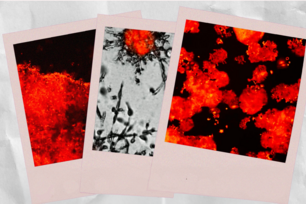Exposing the genetic roots of metastasis
CAMBRIDGE, Mass. — Cancer patients dread hearing that their disease has metastasized (spread to distant tissues) because this usually means a poor prognosis.
Take breast cancer patients. According to the National Cancer Institute, nearly 90 percent of women diagnosed with breast cancer will survive at least 5 years, but their average life expectancy drops to just 18 to 24 months if the cancer cells have already colonized distant parts of the body when their initial diagnosis is made. Scientists are teasing apart the molecular details of this deadly colonization process.
In 2004, Whitehead Member Robert Weinberg’s lab identified two key genes—Twist and FOXC2—that are generally dormant in adult tissues, but active in metastatic cells. Working with breast carcinomas in mice, postdoctoral researchers Jing Yang (now at the University of California, San Diego) and Sendurai Mani showed that Twist causes cells to become invasive, to separate from one another and to spread to distant sites, which is a prerequisite for the eventual formation of metastases (see New insight into cancer metastasis). The results of this investigation were published in the journal Cell. Now the Weinberg lab has uncovered the other gene’s role.
“FOXC2 is very potent in enhancing a cancer cell’s ability to move and invade through tissues,” says Weinberg, who is also an MIT professor of biology.
This aggressive behavior is reminiscent of certain cells in a developing embryo. During the course of embryo growth, some of the cells within the embryo lose their connections to one another and travel to new areas, where they settle and form a number of essential structures and tissues. Twist helps these “explorers” break down their associations with their neighbors and FOXC2 helps them move. The entire process—loss of cell-to-cell adhesion plus migration—is called the epithelial-mesenchymal transition (EMT).
The new study, published June 12 in the Proceedings of the National Academy of Sciences, contributes to the growing body of evidence that cancer cells hijack the normal embryonic EMT process and exploit it for their own purposes. Cancer cells appear to activate important EMT genes, which are ordinarily turned off in adult cells, in order to advance metastasis.
“We’ve shown that FOXC2 is necessary and sufficient to promote metastatic ability in some cancer cells,” says Mani, first author on the study.
He began with a colony of fully metastatic breast cancer cells—capable of seeding primary and secondary tumors—turned off the FOXC2 gene and injected the altered cells into the mammary gland of a mouse. These cells generated primary tumors, but failed to produce secondary tumors. Mani then reversed the experiment by taking a colony of nonmetastatic breast cancer cells, activating FOXC2 and injecting them into a mouse. In addition to forming a primary tumor, the former homebodies ventured to distant tissues and created secondary tumors.
Further experiments allowed him to pinpoint exactly when FOXC2 arrives on the metastatic scene. The gene performs heavy lifting after the cancer cell has already lost its adhesive properties (i.e., after Twist and other genes initiate an EMT). FOXC2 then directs the cell to secrete proteins that clear a path around it, facilitating movement.
But do these results have clinical relevance? Mani collected a number of human breast cancer samples in collaboration with Andrea Richardson at Brigham and Women’s Hospital and checked for FOXC2 activity. A relationship began to emerge.
“Most strikingly, FOXC2 is strongly over-expressed in almost half of invasive basaloid carcinomas of the breast, which represent a particularly grim prognosis for the breast cancer patient,” Weinberg explains. “It’s attractive to speculate that the FOXC2 present in the nucleus of a lot of these tumors is causally responsible for their aggressive clinical behavior, but we haven’t proven that yet.”
***
Mani, S. et al. “Mesenchyme Forkhead 1 (FOXC2) plays a key role in metastasis and is associated with aggressive basal-like breast cancers.” Proceedings of the National Academy of Sciences. 2007 Jun 12;104(24):10069-74.
Topics
Contact
Communications and Public Affairs
Phone: 617-452-4630
Email: newsroom@wi.mit.edu


